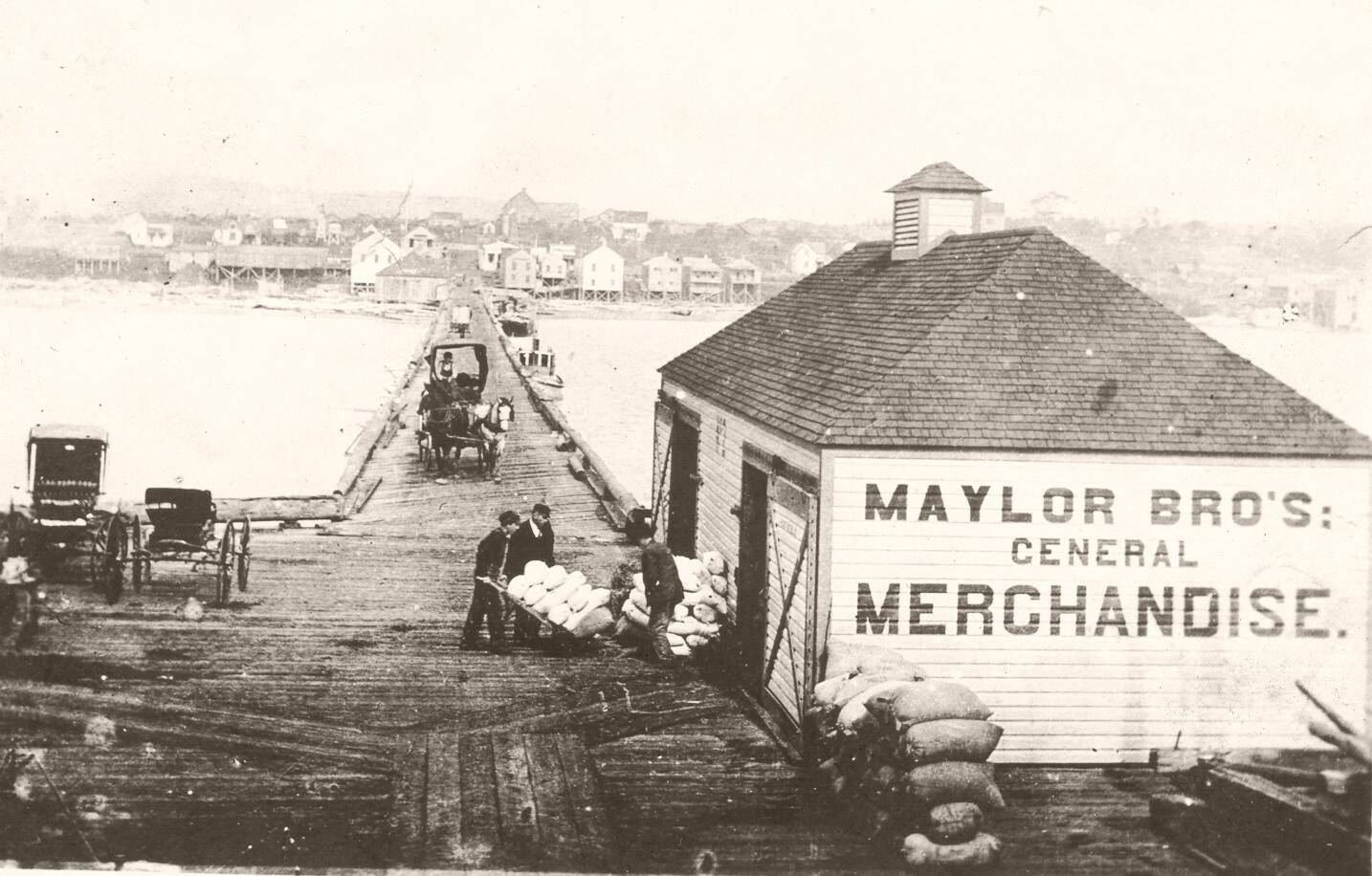Over the decades, downtown Oak Harbor has gone through significant changes, saying good-bye to old-timey businesses and welcoming new ventures, seeing part of Pioneer Way turned into a one-way street and even changing its proximity to the waterfront.
Though some community members might miss the small-town feeling of the old downtown, it remains a place where residents and visitors — whether they’re taking their kids to Popsies or trying on fancy fur coats at A Vintage Affair with their friends— can experience simple yet special moments that can be cherished for a lifetime.
Despite the cold and rainy weather, people flocked to the booths and stores lining Pioneer Way during the city’s 55th annual Holland Happening, making new memories under the unmoving gaze of two of the city’s earliest pioneers: the Barringtons.
The bronze sculpture located on Pioneer Way depicts Edward and Christina Barrington on their wedding day. A lot has changed since the groom, who was a sea captain of Irish and English descent, opened Oak Harbor’s first ever business in the 1850s, before a group of Dutch immigrants from Holland, Michigan, settled on the island in 1894 and built churches, schools and businesses.
His great-great-granddaughter, Author Peggy Darst Townsdin, believes her ancestors would be pleased to see that modern-day Oak Harbor has preserved some of its historical buildings and that the downtown has expanded, currently counting 100 businesses, according to the Main Street Association.
“I think it would be interesting to bring back Barrington and some pioneers and take them around town and show them what is left and what is new,” she wrote in an email.
Walking around downtown, the city’s late old-timers might be delighted to recognize the buildings that housed the Hill General Store (which now is home to PNW Vibes Market and Whidbey Leaf & Vine) and part of what used to be Edward Barrington’s store, saloon and warehouse business (where Kraken’s Cove now stands), among a few others.
Other buildings have not been so lucky, as recounted in Darst Townsdin’s book “Oak Harbor.”
The Barringtons’ mansion, which became a hotel after Edward Barrington’s passing in 1883, was demolished in 1978. In 1920, a fire ravaged the hotel, store, saloon and wharf built by Irish Pioneer Laurence Paul Byrne, as well as the eastern side of the town. In 1966, another fire destroyed the dock built by John and Joe Maylor in 1893.
The city’s first businesses used to be connected by a dirt road that was first named Barrington Avenue and later renamed Pioneer Way. Until the 1960s, downtown was located right on the edge of the water, with a number of businesses on pilings that stood over a slough that was later filled with rocks, concrete and soil. This project, initially dubbed the “Flintstone Freeway,” became today’s Bayshore Drive.
While the city’s old skyline and ways of life are well documented in the book, some current residents still remember what downtown was like back in their day.
Former Mayor Bob Severns, who moved to Oak Harbor in 1974 at the age of 24, believes downtown used to be much busier before the arrival of fast food and grocery store chains, and remembers there used to be four nightclubs where adults would have fun.
State Sen. Ron Muzzall was born in 1963 and is a fourth generation Oak Harbor resident. Back when he was a child, downtown had “everything you needed.”
Muzzall bought his first bike at Chuck Dann’s Sporting Goods, which was located in the same building as the — now closing — restaurant Rustica, and would often join his mother in her shopping trips to the Pioneer Department Store, where she would look for fabrics and sewing patterns to make clothes.
Decades later, Muzzall still remembers observing the rings attached to the curb, which were used to tether horses and wagons before his time.
On that same road, a young Jill Johnson got in trouble for eating candy cigarettes with her friend, blowing out puffs of “smoke” that was actually candy powder.
It was the early 1980s, a time when Oak Harbor, despite its Navy-induced growth, still felt like a small community. Back then, the Island County commissioner was in middle school and would often hang out at Masten’s Variety, a popular five-and-dime store that was located in one of the only three original wooden structures that still stand downtown.
Before she even got home, Johnson’s parents were already waiting to confront her for the alleged transgression.
In a town where people knew each other, it was hard to get away with anything, she said.
Now, the city has become much bigger while people have become busier, more distant from the city center and less social.
To this day, whenever she steps into a restaurant, Johnson feels surprised at the realization that she can’t recognize anyone. Sometimes, she misses how downtown Oak Harbor used to be a place where community members would gather.
Back when Chris’ Bakery was located at the corner of Pioneer Way and Ely Street, the business used to be the place where locals would socialize and discuss the latest news, according to Dave Johnson, Jill Johnson’s father.
Furthermore, as part of a worldwide trend, residents have become more reliant on cars.



